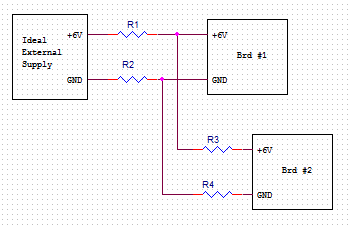glias
Full Member level 2
Hello all,
I have a problem with my board :
I have one analog preamp board which +/-6V supply from a power supply and another one which is connected to the preamp to control a mux which is on the preamp. The second board use a µC and control a LCD display. Thses boards are connected with a flat cable (awg28 about 1.5meter with 20 conductors) to supply the second board and also permit to control the second board.
On the second board, there is a LDO to provide a 5V to supply µC and the display (HCMS2903). The output of the regulator is quite clean, but I have a problem on the input of it : there is a very high AC ripple (about 95mV peak to peak) and as the voltage supply the op amp on my first board, I have this ripple on the preamp board too...
The total consumption of the second board (µC+ display+leds) is about 70mA (average value, I can't tell you the peak current).
I oberved that the display is the cause of this ripple because, when I have changed the program to disable it, the ripple became very low.
I tried to place a big cap on the supply of the display : it doesn't change anything on the input of the LDO, so I tried to place a big cap (1000µF) on the input of the LDO, It improves a little the ripple, but not enough...
What can I do ? place another big caps on the input of the regulator ? or I'm wrong and there is another thing to check and improve ?
I hope that you could help me
thanks
I forget to mention you that I have placed a tantalum cap on the supply of the display (it's not specified on the schematic) and one 100µF-16V electrolytic cap on the input of the LDO and another one on the output as specified in the datasheet.
Without 1000µF-16V electrolytic cap :

With 1000µF-16V electrolytic cap :

I have a problem with my board :
I have one analog preamp board which +/-6V supply from a power supply and another one which is connected to the preamp to control a mux which is on the preamp. The second board use a µC and control a LCD display. Thses boards are connected with a flat cable (awg28 about 1.5meter with 20 conductors) to supply the second board and also permit to control the second board.
On the second board, there is a LDO to provide a 5V to supply µC and the display (HCMS2903). The output of the regulator is quite clean, but I have a problem on the input of it : there is a very high AC ripple (about 95mV peak to peak) and as the voltage supply the op amp on my first board, I have this ripple on the preamp board too...
The total consumption of the second board (µC+ display+leds) is about 70mA (average value, I can't tell you the peak current).
I oberved that the display is the cause of this ripple because, when I have changed the program to disable it, the ripple became very low.
I tried to place a big cap on the supply of the display : it doesn't change anything on the input of the LDO, so I tried to place a big cap (1000µF) on the input of the LDO, It improves a little the ripple, but not enough...
What can I do ? place another big caps on the input of the regulator ? or I'm wrong and there is another thing to check and improve ?
I hope that you could help me
thanks
I forget to mention you that I have placed a tantalum cap on the supply of the display (it's not specified on the schematic) and one 100µF-16V electrolytic cap on the input of the LDO and another one on the output as specified in the datasheet.
Without 1000µF-16V electrolytic cap :

With 1000µF-16V electrolytic cap :


